Environment: milieu / climate zone / depth range / distribution range
Ökologie
seewasser demersal; tiefenbereich 30 - 71 m (Ref. 9824). Tropical; 14°N - 24°S, 95°E - 134°E (Ref. 9824)
Indo-West Pacific: Persian Gulf to the coast of India; north to Taiwan through the South China Sea, south to Queensland. Specimens from northern and Western Australia often treated as distinct subspecies (Ref. 9824).
Size / Gewicht / Alter
Maturity: Lm ? range ? - ? cm
Max length : 19.0 cm TL Männchen/unbestimmt; (Ref. 9824); common length : 7.5 cm TL Männchen/unbestimmt; (Ref. 9824)
Rückenflossenweichstrahlen (insgesamt) : 80 - 84; Afterflossenweichstrahlen: 61 - 64.
Inhabits sand and mud bottoms (Ref. 9824). Feeds on bottom-living animals (Ref. 9824). Taken in shrimp trawls (Ref. 9824).
Life cycle and mating behavior
Geschlechtsreife | Fortpflanzung | Ablaichen | Eier | Fecundity | Larven
Kuronuma, K. and Y. Abe, 1986. Fishes of the Arabian Gulf. Kuwait Institute for Scientific Research, State of Kuwait, 356 p. (Ref. 5999)
IUCN Rote Liste Status (Ref. 130435: Version 2024-2)
Bedrohung für Menschen
Harmless
Nutzung durch Menschen
Fischereien: weniger kommerziell
Tools
Zusatzinformationen
Download XML
Internet Quellen
Estimates based on models
Preferred temperature (Ref.
123201): 26.2 - 28.6, mean 27.9 °C (based on 215 cells).
Phylogenetic diversity index (Ref.
82804): PD
50 = 0.5000 [Uniqueness, from 0.5 = low to 2.0 = high].
Bayesian length-weight: a=0.00912 (0.00408 - 0.02036), b=3.04 (2.85 - 3.23), in cm total length, based on LWR estimates for this (Sub)family-body shape (Ref.
93245).
Trophic level (Ref.
69278): 3.5 ±0.37 se; based on food items.
Widerstandsfähigkeit (Ref.
120179): mittel, Verdopplung der Population dauert 1,4 - 4,4 Jahre. (Preliminary K or Fecundity.).
Fishing Vulnerability (Ref.
59153): Low vulnerability (10 of 100).
